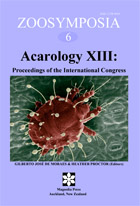Abstract
Decline in rainforest cover in many areas ofAustralia is being countered by various methods of forest reestablishment, including ecological restoration plantings, timber plantations, and unmanaged regrowth.We used assemblages of soil- and litter- dwelling mites to determine which style most closely recaptures the assemblage structure of mites associated with intact rainforest at 84 tropical and subtropical sites in eastern Australia. The six habitat types surveyed were pasture (the typical ‘pre-restoration’ state), unmanaged regrowth, monoculture forestry, multi-species forestry, ecological restoration and intact rainforest (the ‘target’state). Forestry and ecological restoration sites were 5–20 years old.Mites were extracted fromsoil/litter samples and (excluding Oribatida) identified to family or to finer levels. For two diverse but taxonomically difficult superfamilies characteristic of rainforest,Uropodoidea and Trombidioidea, identificationwas tomorphotaxon. Presence/absence data were analyzed in several ways. First, we used our data to create a list of ‘indicator taxa’ for pasture and rainforest, and determined the abundance of these indicators in each of the four reforestationmethods.We also calculatedmorphotaxon richness for uropodoids and trombidioids and compared these values among habitat types. In both of these analyses, ecological restoration was most similar to rainforest.We used ordination andANOSIM to compare mite assemblages among habitattypes. Althoughmite assemblages clearly distinguished between rainforest and pasture sites, they did not identify any of the four reforestation methods as being consistently similar to rainforest. They did, however, indicate that monoculture forestry and multi-species forestry plantations were often not readily distinguishable from pasture. This may have as much to do with silviculturalmethods common to these plantations (e.g., pruning, herbicide application, andmaintenance of a relatively open canopy) as to the low diversity of trees present in plantations. We conclude with a brief discussion of the utility of mites in rapid bioassessment programs in Australia, and suggest that the most pragmatic approach involves focusing on a few easily recognized indicators rather than on entire assemblages.

